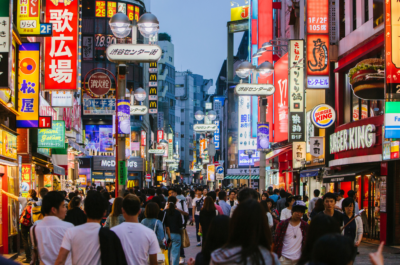
JNTO has developed policies to promote sustainable tourism in Japan, which will contribute to the accomplishment of the SDGs. This will be done by preserving and enhancing local habitats and biodiversity while also respecting the culture of local communities.
As per the latest findings of Future Market Insights, global Japan tourism revenue is expected to be US$ 208,926 Million by the end of 2023. In the long-term, the Japan tourism is estimated to reach at around US$ 559,470 Million in 2033.
2018 to 2022 Japan Tourism Market Outlook Compared to 2023 to 2033 Forecast
As per the latest update by Future Market Insights, the Japan tourism market is forecast to increase at a prolific CAGR between 2023 and 2033. Nippon, Nihon, the land of the rising sun, Japan is the country synonymous with ancient cultural heritage, Buddhist religious traditions and a fast-paced lifestyle replete with world-class airports, top-notch infrastructure and modern technology co-existing side by side.
It was the first country to modernize in Asia; suffered enormous destruction in World War Il; but nonetheless rose from the ashes within two decades to become Asia’s most powerful economy once again! So quickly did the country take its place among global heavyweights that the boom was rightfully called the ‘Japanese economic, miracle’! While access to Japan was tightly controlled by the Shogun in the Renaissance period, the Meiji Restoration of 1867 and the building of a national rail network made tourism affordable for domestic tourists and possible for international tourists.
The government recognized the need for organized tourism catering to foreign tourists as early as 1887 and established the Kihinkai with the then Prime Minister Hirobumi’s blessings. Another major development was passing the Hotel Development Law in 1907, which enabled the Railways Ministry to construct publicly owned hotels across the breadth of Japan.
Japanese Sport Tourism is one of the major drivers of the overall Japan Tourism Market
The sports tour is well-positioned to be an important component of the Japanese government’s efforts to achieve economic GDP development. Japan has had great success attracting and hosting mega-events, particularly spectator events. It held the Summer Olympics in 1964 and again in 2021. Japan has also been the host of Asian Games, FIFA World Cup and various other championships.
Japan, with its immense natural resources, provides countless opportunities throughout the four seasons. Trail running, river rafting, and marine sports, as well as skiing and snowboarding, attract a lot of tourists. In addition to participating in numerous sports, participants have the option to explore and enjoy cultural heritage places or rich fauna in the surrounding area.
Marine resources, mountain resources, suburban resources, and snow and ice resources are the four distinct categories of natural tourism resources in Japan. Municipalities and local governments can use these resources to develop and provide sporting activities. This is likely to increase demand for sports tourism in Japan.
Promotion of sustainable tourism in Japan likely to attract visitors
In recent years, the fast-paced increase in global tourism has coincided with increased concern in many countries about its consequences to the environment and the lives of those who work in famous tourist sites. The COVID-19 pandemic has also exacerbated these fears. Even before the outbreak of Covid-19, the massive spike in the number of foreign tourists to Japan was raising concerns of overcrowding and pollution as well as the accompanying pressure on local inhabitants and towns.
The UN’s World Tourism Organization has advocated for “sustainable tourism”. Recognizing its obligations as the world’s third-largest economy, Japan is taking tangible actions to promote these global goals. JNTO has developed policies to promote sustainable tourism in Japan, which will contribute to the accomplishment of the SDGs. This will be done by preserving and enhancing local habitats and biodiversity while also respecting the culture of local communities.
One instance of sustainable tourism is Seto Island Sea is the launch of a tour by The Seto Inland Sea Ecotourism Council of the Inland Sea. The excursion, dubbed a “adult study trip,” incorporates boat viewing with study of the local environment and its culture. Such initiatives are bound to attract overseas tourists in Japan.
Need to Focus on Other Destinations in Japan for Tourism Instead of just the Popular Destinations
According to a 2019 Japan Tourism Agency poll, 47% of visitors stopped in Tokyo and 39% in Osaka. However, for over half of the country’s 47 regions, the figure was 1% or less. As per Joseph Cheer, a professor at Wakayama University‘s Center for Tourism Research, the government should go beyond prominent sites and prepare other destinations to deal with tourism in the post-COVID age.
He also emphasized on the need to devise a long-term strategy of distributing tourists throughout the nation rather than having them focused in the primary places. This can only be done with the help of government support in the form of infrastructure development, necessary English training for personnel at information centers and traditional ryokan inns and giving financial assistance in rural areas. There is a lot of Japanese culture and culinary outside of the major metropolitan areas.
It is Important for Japan to Break Free from its Heavy Dependence on East Asian Visitors.
China solely contributed for 30% of total visits in 2019. South Korea came in second with 17%. Consequently, 70% of total tourists in Japan were from four regions, namely China, South Korea, Taiwan and Hong Kong. There is an over-reliance on specific economies which makes it vital to break free from this dependency in terms of risk mitigation.
Due to strained diplomatic relations with any of the four mentioned regions, traffic could be significantly hampered. South Korean tourists to Japan, for example, fell by a significant amount in 2019 compared to the previous year as the bilateral relationship deteriorated. Thus, to avoid such dependency, the need of the hour is to find a balance by increasing the number of inbound tourists from Australia, US, Europe as well as regional markets such as Singapore and Malaysia.
Category-wise Insights
Middle-aged Travelers are Most Likely to Travel Overseas
The 26-35 age group has the largest market share. This age group represents a generation of working professionals who have yet to travel to many regions of the world. They are able to do so since the majority of them have the spending capacity as well as good health to take overseas tours. They are typically the ones who commence the decision-making process. Furthermore, they have a better understanding of how to acquire the most recent information in terms of technology.
There will be a Surge in the Number of Independent Travelers
In the last few years there have been rapid technological advancements due to which a large number of people have become quite comfortable with emerging technologies and are well equipped to adapt to change. Consequently, this has led to an increase in the number of independent travelers and is forecasted to only increase further.
Online Booking Channels Lead the Booking Channel Segmentation
Tourists enjoy taking holidays, but for many, planning the trip is also a big part of that enjoyment. It usually takes a lot of time and effort to research and make a decision before purchasing travel tickets, accommodations, tours, or any other supplementary services or modes of transportation. However, the existence of online travel agencies has unquestionably both sped up the procedure and offered clients access to more choices.
People who book their vacations online prefer to compare travel on booking portals and hotel websites. Offline, however, arranging a trip is carried out with the aid of a travel company or a tour operator. The “Hashtag Generation,” which includes Millennials and Generation Z, is more likely to try new things and seek out new experiences.
Competitive Landscape
There are many suppliers who are assuring a safe and affordable travel experience, which has made travel and tourism possible and at ease. Instances of key players and collaborations in the market place are
JTB is the largest travel agency in Japan and has contributed to the Japanese travel industry for 110 years. It has made the globe aware of the attractiveness of Japanese tourism.
The local promotion group, Visit Hachinohe, has initiated marketing initiatives in the United Kingdom, France, and Taiwan, engaging with travel businesses and the media. In addition, the organization worked with the Junior Chamber International Hachinohe, a local group of young businesses, to create a network of traveler-friendly restaurants and stores, with plans to publish a map of “welcome shops” on its website.
Vicky is the co-founder of TravelDailyNews Media Network where she is the Editor-in Chief. She is also responsible for the daily operation and the financial policy. She holds a Bachelor's degree in Tourism Business Administration from the Technical University of Athens and a Master in Business Administration (MBA) from the University of Wales. She has many years of both academic and industrial experience within the travel industry. She has written/edited numerous articles in various tourism magazines.















































































